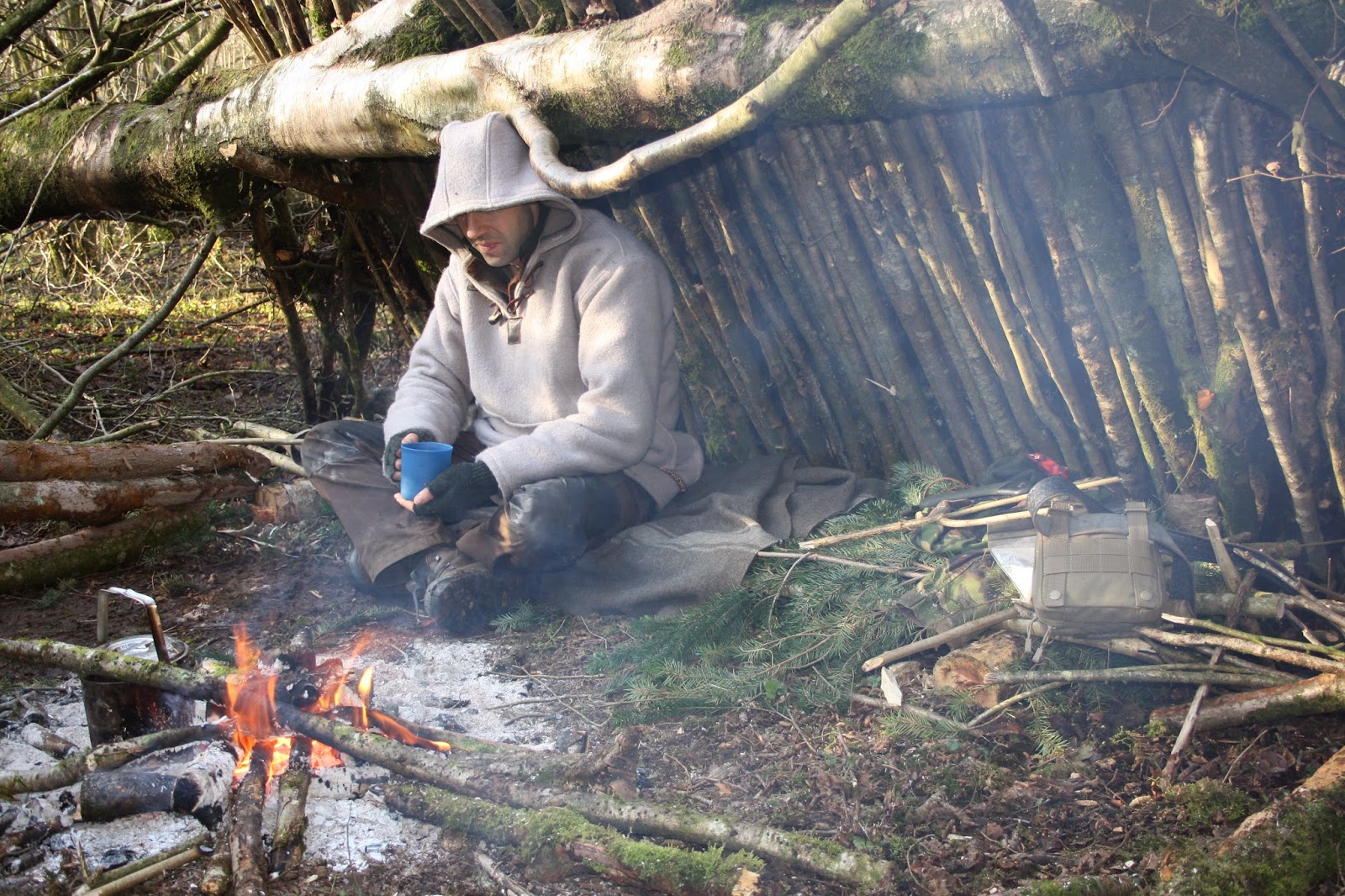Bushcraft training and survival training are often thought
of as two quite different creatures however, there is a point where the two
merge and cross over. The Winter Bushcraft Challenge which took place at our Wiltshire
woodland site last weekend, is definitely one of those hybrids. Designed as a
testing 48 hour exercise, it aims to address some of the essential requirements
for wilderness living from a bushcrafters perspective. Kit, clothing and food
are deliberately limited at the coldest, wettest time of the year to truly test
the participants understanding of survival priorities, their knowledge and
their skill in implementing wilderness survival skills training.
Before signing up, participants must have an existing level
of skill and knowledge, including a realistic awareness of survival
strategy’s in the event of an unexpected be-nightment at the mercy of the
elements. In a typical UK based emergency scenario such as this, the recommended
course of action would be to seek immediate, safe shelter and do everything
possible to conserve body heat, paying special attention to where and how this might be
lost (conduction, convection...). Precious energy would need to be retained for
keeping warm during the long night, possibly only invested in improving your
shelter or making your position more visible to rescuers. Hopefully by
hunkering down in this manner you would be alive, safe and well the following
morning.
Utilising a fallen birch tree as a shelter framework
Burning 'bony oak' for long lasting warmth through the night
Additional items on the limited kit list include a belt
knife, small folding saw, a Swedish fire steel, one metal cooking pot, a wooden
cup and a handful of safety gear (torch, whistle, phone, first aid kit).
Participants are also given a small amount of wild game and rice to sustain
them for the 24 hour duration. Even this relatively modest meal obviously requires
cooking before eating, meaning that energy must be invested before energy can
be obtained. Water too, is deliberately difficult to come by and must be boiled
before drinking – a mean trick again designed to get participants thinking carefully
about prioritising their survival needs. Almost every decision made in such
testing conditions carries consequences and there will always be a trade-off.
Any mistakes made only serve to enlighten the participants further, providing
the kind of personal experience impossible to obtain from a book, demonstration
or lecture.
A hot cup of pine, fir or spruce needle tea is just the job!
Let me stress once again, such a strategy would most likely be a gamble too far in many typical UK survival type scenarios and the kind of natural resources required to build shelter, light fire etc, unlikely to be immediately at hand on your average remote Scottish hillside. I would always encourage anyone venturing out into the wilder parts of this island and similar environments to carry a suitable lightweight shelter system (bothybag, bivi bag, tarp) as well as enough warm layers (blizzard bag, down jacket) and high energy food to help maintain core temperature during the long, winters night. See this suggested packing list for advice
This challenge is less about employing bushcraft skills in a
realistic survival scenario and more about encouraging a feeling of self-reliance
and total confidence in ones abilities, a heightened awareness of natural
resources and less dependency on the reliability of carried survival kits. We’re
also preparing for the extremes and the unexpected where a carried survival kit might not provide all the answers. What if it's so cold that just hunkering down
won't be enough? What if your clothing and kit are soaked, damaged, inadequate,
lost or possibly not even there in the first place? Having confidence in your
abilities as well as personal experience to draw upon will ensure a more level
head is maintained when sh** meets fan, rather than the onset of panic and a mental barrage
of partially retained yet untested information. Your situation may not be
exactly the same as this self -imposed practice run but you'll have raised your
chances considerably. You’ll know what's possible and what would be dangerous
to attempt. Ultimately, you’ll know exactly what you're personally capable of!
Imaginary survival situation aside, your desire to learn bushcraft
might stem from an interest in natural history or experimental archaeology. You
might have no real interest in survival techniques at all. Reducing kit to a
minimum for a challenge such as this puts more emphasis on traditional wilderness
living skills, adding meat to their bones and giving them real meaning.
Rear view of a lean to shelter showing the thickness of thatch required to keep the winter weather at bay
Don't forget the insulation between you and the cold earth. Here, Doug fir boughs make a perfect mattress
Your interest in bushcraft might just be about shedding the confusing
clutter of modern life, lightening your mental load, regaining control over
your life. The knowledge that you can provide everything you need with your own
two hands, hard work and grim determination is unbelievably empowering…even if
it is only for a weekend!
You might just enjoy the adventure…
Whatever the reason for learning bushcraft, I like to think
of challenges such as these, as a final part of the jigsaw.
The Winter Bushcraft Challenge will run again in 2015…but
you better be ready! Preparation should include knowledge of building natural
shelters, beds, bindings and cordage, well-practiced wet weather fire lighting
skills, experience in preparing and cooking various types of wild game, water
purification techniques, a good knowledge of wild plants, trees and their uses
as well as an honest, hearty helping of just getting out there and doing it!
For everything you need to know, look here











Those look reasonably comfortable. I can see how an open faced shelter would work with a fire.
ReplyDelete